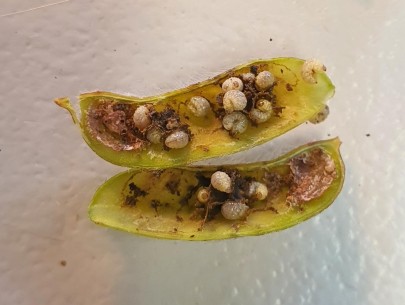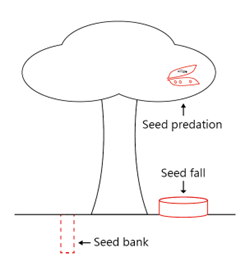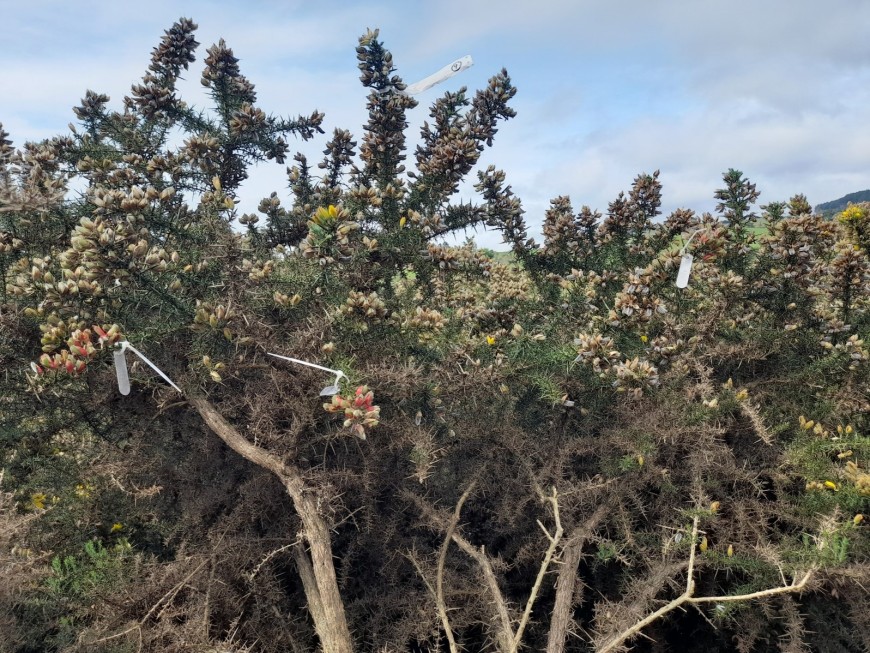Are Gorse Seed Feeders Hungry Enough for Change?
Six biocontrol agents have been successfully established to control gorse, starting with the gorse seed weevil (Exapion ulicis), which was first released in 1931. At the time, a seed feeder was chosen to reduce the spread of the weed but avoid affecting gorse hedges. Later the gloves came off in the biological fight against gorse and new agents were introduced in the 1990s: the gorse pod moth (Cydia succedana), gorse soft shoot moth (Agonopterix umbellana), gorse spider mite (Tetranychus lintearius), and gorse thrips (Sericothrips staphylinus), and lastly the gorse colonial hard shoot moth (Pempelia genistella) in 1998.
It is now around 30 years on from the bulk of these releases, and Paul Peterson and colleagues have started investigating the impact of these biocontrol agents on gorse populations. The focus of their recent work has been on gorse seed feeders (i.e. the gorse seed weevil and gorse pod moth). Gorse produces a prolific number of seeds that help it to rapidly colonise whole landscapes. Because of this trait, seed feeders have been seen as a key component of successful biocontrol and overall management of the weed.

Image: gorse pod moth (top) and gorse seed weevil (bottom) larvae.
“Various studies have tried to determine the impacts of seed feeders on gorse seed production and seed banks over the years, but up until now they have lacked the data to describe the reduction in seed fall due to seed predation by the seed-feeding biocontrol agents, and the subsequent impact on gorse cover,” said Paul.
In 2022 the team surveyed two sites where both of the seed-feeding biocontrol agents were present: one in Christchurch in the South Island and one in Palmerston North in the south-east of the North Island. At each site 15 gorse bushes were selected and measurements taken to determine percentage seed predation by counting the number of healthy versus predated seeds from 10 randomly selected shoots per bush. The same bushes were also measured for seed fall per square metre by placing trays under the bushes to catch falling seeds. Also, the number of seeds per square metre stored in the ground (the seed bank) was measured by taking two soil cores under each bush and counting the seeds in each.

Image: types of gorse seed collection.
This data was then compared with models produced from a study by Richard Hill (MWLR Research Associate) and M. Rees (Imperial College, UK) in 2001, which predicted that reductions in gorse cover on a landscape scale could occur under various theoretical seed reduction and management scenarios.
This is where it gets a bit complicated. These models found the primary drivers of gorse invasion and cover to be recruitment (the process whereby new individuals are added to the population) and disturbance (a temporary change in environmental conditions that causes a pronounced change in an ecosystem). Gorse requires a lot of seed fall to maintain high recruitment, and when seed fall drops below a certain threshold it can lead to eventual extinction of the population. But this threshold is a moving target and is dependent on disturbance rates in the area. Gorse needs a moderate amount of disturbance in a landscape, such as landslides or tree fall. With too little disturbance there is no new space for seedlings to grow. On the other hand, too much disturbance and gorse can’t persevere under the constant change in environment.
There is one more important caveat. These prediction models are also dependent on seedling survival being low. When the models were run with an assumption of high seedling survival, all the scenarios required a very high, and unlikely level of disturbance coupled with a very low, and unlikely, seasonal seed fall, meaning there would be a very narrow set of circumstances that would need to align for local gorse extinction to occur.
Seedling survival rates will be a concern for many sites across New Zealand, but Paul said, “At the Christchurch and Palmerston North sites, where disturbance has been low since earlier fires and clearing of vegetation, the low seedling survival due to rank grass covering the ground means there is the potential for gorse cover to be reduced if the biocontrol agents can achieve a moderate reduction in seed fall.”

Image: gorse and tagged shoots.
The recent survey work by the team found that at the Palmerston North site the estimated total seed produced by gorse in a season was 6,908 seeds/m2. There was 24% seed predation by biocontrol agents, which left 5,250 seeds/m2 to reach the ground (seed fall), and this was culminating in a seed bank averaging a whopping 23,695 seeds/m2. At the Christchurch site the estimated total seed produced was much lower, at 1,072 seeds/m2, with much higher seed predation by the biocontrol agents at 60%. This leaves an average of 429 seeds/m2 reaching the ground (seed fall) and is reflected in the seed bank averaging only 4,312 seeds/m2.
The gorse pod moth accounted for most of the seed predated at the Palmerston North site (17%) while the gorse seed weevil was dominant at the Christchurch site, accounting for 42% of the predated seed.
So, what numbers did the theoretical models predict?
Richard and Mark took an estimated total natural seed production of 8,888 seeds/m2 at a site and modelled four theoretical seed reduction scenarios: 0% seed fall reduction (8,888 seeds/m2), 50% seed fall reduction (4,444 seeds/m2), 75% seed fall reduction (2,222 seeds/m2), and 95% seed fall reduction (444 seeds/m2).
Under the assumption of low seedling survival, the models showed that if seed fall was below 444 seeds/m2, this could eventually drive a gorse population to extinction, regardless of how much disturbance occurred at the site; whereas if seed fall was greater than 4,444 seeds/m2, local extinction was only likely if disturbance was also very frequent.
This is good news for the Christchurch site, which probably has low seedling survival. The total seed fall count was only 429 seeds/m2, which indicates that the population of gorse should reduce over time, assuming there are no changes in seedling survival rates. Unfortunately, for the Palmerston North site, which had 5,250 seeds/m2, the results were more comparable to the 0–50% (8,888 seeds/m2, 4,444 seeds/m2) seed fall reduction models, meaning this site would need a very high level of disturbance and achieve low seedling survival to reduce the gorse population.
The work by Paul and his colleagues offers likely outcomes at two sites in New Zealand. Sites throughout the country vary hugely, but managing for low seedling recruitment will be key for obtaining the greatest impact from seed-feeding biocontrol agents. Management practices that kill plants, prevent or substantially reduce subsequent recruitment, and reduce seedling survival will be required to reduce gorse cover, regardless of seed predation levels.
Recent evidence from broom studies suggests that pollinator management could also be critical to gorse seed production and reducing seed banks. Pollination is an area that has been overlooked in the past, but reducing beekeeper access to vulnerable areas, in combination with seed predation by biocontrol agents, may prove critical in areas where reduced seedling survival cannot always be sustained.
Overall, seed-feeding biocontrol agents can help to reduce long-term gorse cover under certain circumstances by driving seed fall below threshold levels. However, good land management decisions will still be required to prevent seedling recruitment or, if there is a disturbance, to target seedlings before they flower.
Contact

